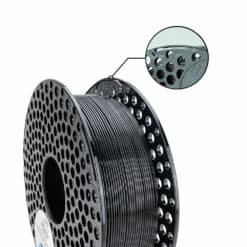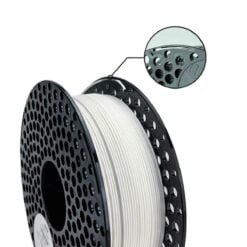ABS Prime
ABS Prime is our high-end zero warp engineering filament, based on regular ABS (acrylonitrile butadiene styrene). Due to our enhanced formulation, ABS Prime has exceptional strength with an increased impact resistance and excellent interlayer adhesion. With ABS Prime you will create precise, detailed prints that are both durable and have a beautiful surface finish.

To know more about ABS Prime filaments, read our blog.
Printing recommendations:
- For the best results, print at 240–265°C*.
- Recommended printing bed temperature is 70-100°C. We recommend using an enclosure or enclosed 3D printer, though this material can be printed without an enclosure.
- We highly recommend using the thick and textured PEI sheets/glass, as the rigidity and strength of ABS Prime require the weight and/or magnetic pull of a high-quality printing bed.
*Ideal temperature may vary when using different printers.
Smoothing techniques
A common way to smoothen the surface of your 3D printed ABS Prime object is by applying acetone to its surface. We recommend submerging the object in acetone directly as opposed to using vapour smoothing.
Applications
ABS Prime has zero warping and excellent interlayer adhesion, which allows for a significantly smoother printing process in comparison to printing with regular ABS, with no compromises on its mechanical properties.
Zero warping
When printing with regular high-performance materials such as ABS, one often comes across the issue of warping. Warping occurs when the edges of a printed part lift off the printing bed, causing deformation of the print. In combination with poor interlayer adhesion, cracks will form, leading to an overall reduction in the appearance and functionality of the print. Due to our enhanced formula, ABS Prime has zero warping and excellent interlayer adhesion, which eliminates these common issues of ABS altogether.
High heat resistance
ABS Prime has a high heat resistance, making it an extremely suitable material for printing parts that need to withstand higher temperatures. For this reason, ABS Prime is used to print prototypes and end-user parts that are to be tested under vigorous, real-world circumstances.

High impact strength
The term ‘impact strength’ refers to the ability of a material to resist deformation, cracking and fracturing under sudden and intense impact. ABS Prime has a high impact strength, meaning it can resist a high amount of impact without influencing the integrity of your print.
Excellent interlayer adhesion
ABS Prime has excellent interlayer adhesion, an attribute that is crucial for ensuring the structural integrity and strength of printed parts. Good interlayer adhesion minimizes the risk of cracking under pressure and creates a smoother printing process.
High-precision printing with fine detail
With ABS Prime, you can create prints that showcase the most intricate details without compromising on the mechanical properties you expect out of a high-engineering-grade material.

Reduced smell
ABS Prime has significantly less smell during printing compared to regular ABS, making it more pleasant to work with. Though ABS Prime has a reduced release of certain toxins and fumes when the material is heated, we still recommend working with 3D printers in a well-ventilated space.
Product Storage
We recommend storing the filament in a cool, dry enclosed space with a silica desiccant packet, away from UV light.
Features & Properties
| Standard | XY Value | XZ Value | ZX Value | Unit | |
|---|---|---|---|---|---|
| Tensile Strength | ISO 527-2 | 30.9 | 33.5 | 11.5 | MPa |
| Yield Strength | ISO 527-2 | 25.2 | 26.6 | / | MPa |
| Tensile Modulus | ISO 527-2 | 1600 | 1600 | 1400 | MPa |
| Strain at Yield | ISO 527-2 | 3.2 | 3.2 | 0.9 | % |
| Flexural Strength | ISO 178 | 47.3 | 55.5 | 24.3 | MPa |
| Flexural Modus | ISO 178 | 1600 | 1700 | 1500 | MPa |
| Impact Strength | ISO 179 | 55.5 | / | / | kJ/m² |
You can access the Technical Data Sheet and Safety Data Sheet here.




























